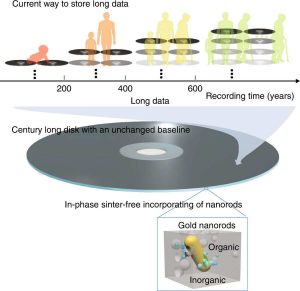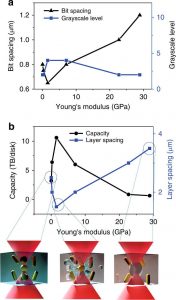R&D: Next-gen Optical Disk to Solve Storage Challenge
Continuous multi-level recording and reading with capacity over 10TB with no appreciable change of baseline over 600 years
This is a Press Release edited by StorageNewsletter.com on March 27, 2018 at 2:04 pmFrom RMIT University, Australia
Scientists from Australia and China have drawn on the durable power of gold to demonstrate a new type of high-capacity optical disk that can hold data securely for more than 600 years.
The technology could offer a more cost-efficient and sustainable solution to the global data storage problem while enabling the critical pivot from Big Data to Long Data, opening up new realms of scientific discovery.
The recent explosion of big data and cloud storage has led to a parallel explosion in power-hungry data centres.
These centres not only use up colossal amounts of energy – consuming about 3% of the world’s electricity supply – but largely rely on hard disk drives that have limited capacity (up to 2TB per disk) and lifespans (up to two years).
Now scientists from RMIT University and Wuhan Institute of Technology have used gold nanomaterials to demonstrate a next-generation optical disk with up to 10TB capacity – a storage leap of 400% – and a six-century lifespan.
The technology could radically improve the energy efficiency of data centres – using 1000 times less power than a hard disk centre – by requiring far less cooling and doing away with the energy-intensive task of data migration every two years. Optical disks are also inherently far more secure than hard disks.
Lead investigator, Min Gu, distinguished professor, RMIT, said the research paves the way for the development of optical data centres to address both the world’s data storage challenge and support the coming ‘Long Data’ revolution.
“All the data we’re generating in the big data era – over 2.5 quintillion bytes a day – has to be stored somewhere, but our current storage technologies were developed in different times,” Gu said. “While optical technology can expand capacity, the most advanced optical disks developed so far have only 50-year lifespans. Our technique can create an optical disk with the largest capacity of any optical technology developed to date and our tests have shown it will last over half a millennium.“…. “While there is further work needed to optimise the technology – and we’re keen to partner with industrial collaborators to drive the research forward – we know this technique is suitable for mass production of optical disks so the potential is staggering.”
The world is shifting from big data towards long dData, which enables new insights to be discovered through the mining of massive data sets that capture changes in the real world over decades and centuries.
Lead author, Dr Qiming Zhang, senior research fellow, School of Science, RMIT, said the new technology could expand horizons for research by helping to advance the rise of Long Data.
“Long Data offers an unprecedented opportunity for new discoveries in almost every field – from astrophysics to biology, social science to business – but we can’t unlock that potential without addressing the storage challenge,” Zhang said. “For example, to study the mutation of just one human family tree, 8 terabytes of data is required to analyse the genomes across 10 generations. In astronomy, the Square Kilometre Array (SKA) radio telescope produces 576 petabytes of raw data per hour.“….“Meanwhile the Brain Research through Advancing Innovative Neurotechnologies (BRAIN) Initiative to ‘map’ the human brain is handling data measured in yottabytes, or one trillion terabytes“… “These enormous amounts of data have to last over generations to be meaningful. Developing storage devices with both high capacity and long lifespan is essential, so we can realise the impact that research using Long Data can make in the world.”
The novel technique behind the technology – developed over five years – combines gold nanomaterials with a hybrid glass material that has outstanding mechanical strength.
The research progresses earlier groundbreaking work by Gu and his team that smashed through the seemingly unbreakable optical limit of blu-ray and enabled data to be stored across the full spectrum of visible light rays.
How it works
The researchers have demonstrated optical long data memory in a novel nanoplasmonic hybrid glass matrix, different to the conventional materials used in optical discs.
(Copyright: Nature Communications)
Glass is a highly durable material that can last up to 1,000 years and can be used to hold data, but has limited storage capacity because of its inflexibility.
The team combined glass with an organic material, halving its lifespan but radically increasing capacity.
To create the nanoplasmonic hybrid glass matrix, gold nanorods were incorporated into a hybrid glass composite, known as organic modified ceramic.
The researchers chose gold because like glass, it is robust and highly durable. Gold nanoparticles allow information to be recorded in five dimensions – the three dimensions in space plus colour and polarisation.
The technique relies on a sol-gel process, which uses chemical precursors to produce ceramics and glasses with better purity and homogeneity than conventional processes.
The research was led by Gu and Zhang, Laboratory of Artificial-Intelligence Nanophotonics, RMIT and the RMIT node of Centre for Ultrahigh bandwidth Devices for Optical Systems (CUDOS), along with collaborators from the School of Materials Science and Engineering, Wuhan University of Technology and the Faculty of Engineering, Monash University.
Article: High-capacity optical long data memory based on enhanced Young’s modulus in nanoplasmonic hybrid glass composites
Nature Communications has published an article written by Qiming Zhang, Laboratory of Artificial-Intelligence Nanophotonics and CUDOS, School of Science, Melbourne, VIC, 3001, Australia, Zhilin Xia, Department of Materials Science and Engineering, Faculty of Engineering, Monash University, Clayton, VIC, 3800, Australia, and School of Materials Science and Engineering, Wuhan University of Technology, Wuhan, Hubei, 430070, China, Yi-Bing Cheng, Department of Materials Science and Engineering, Faculty of Engineering, Monash University, Clayton, VIC, 3800, Australia, and State Key Laboratory of Advanced Technology for Materials Synthesis and Processing, Wuhan University of Technology, Wuhan, 430070, Hubei, China, Min Gu, Laboratory of Artificial-Intelligence Nanophotonics and CUDOS, School of Science, Melbourne, VIC, 3001, Australia, and Centre for Micro-Photonics, Faculty of Science, Engineering and Technology, Swinburne University of Technology, Hawthorn, VIC, 3122, Australia.
High-capacity optical data memory in nanoplasmonic hybrid glass composites. (a) Bit spacing and gray-scale level of optical data memory of nanoplasmonic hybrid glass composites with different Young’s moduli. (b) Capacity and layer spacing of the optical data memory in nanoplasmonic hybrid glass composites. Inset: Schematic drawing of laser melting of gold nanoparticles in low Young’s modulus (left), laser melting of gold nanoparticles with smaller spot size in enhanced Young’s modulus (Middle), and laser induced micro-explosion in high Young’s modulus (right)
Abstract : “Emerging as an inevitable outcome of the big data era, long data are the massive amount of data that captures changes in the real world over a long period of time. In this context, recording and reading the data of a few terabytes in a single storage device repeatedly with a century-long unchanged baseline is in high demand. Here, we demonstrate the concept of optical long data memory with nanoplasmonic hybrid glass composites. Through the sintering-free incorporation of nanorods into the earth abundant hybrid glass composite, Young’s modulus is enhanced by one to two orders of magnitude. This discovery, enabling reshaping control of plasmonic nanoparticles of multiple-length allows for continuous multi-level recording and reading with a capacity over 10 terabytes with no appreciable change of the baseline over 600 years, which opens new opportunities for long data memory that affects the past and future.“












 Subscribe to our free daily newsletter
Subscribe to our free daily newsletter

